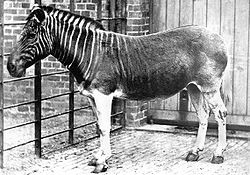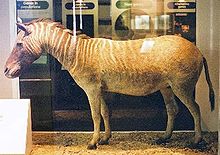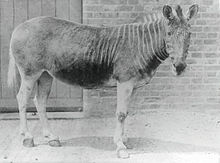- Quagga
-
For the network routing software, see Quagga (software). For other uses, see Quagga (disambiguation).
Quagga 
Quagga in London Zoo, 1870 Conservation status Scientific classification Kingdom: Animalia Phylum: Chordata Class: Mammalia Order: Perissodactyla Family: Equidae Genus: Equus Subgenus: Hippotigris Species: E. quagga Subspecies: †E. q. quagga Trinomial name †Equus quagga quagga
Boddaert, 1785The quagga (Equus quagga quagga) is an extinct subspecies of the plains zebra,[2] which was once found in great numbers in South Africa's Cape Province and the southern part of the Orange Free State. It was distinguished from other zebras by having the usual vivid marks on the front part of the body only. In the mid-section, the stripes faded and the dark, inter-stripe spaces became wider, and the rear parts were a plain brown. The name comes from a Khoikhoi word for zebra and is onomatopoeic, being said to resemble the quagga's call. The only quagga to have been photographed alive was a mare at the Zoological Society of London's Zoo in Regent's Park in 1870.
Contents
Range and habitat
The quagga lived in the drier parts of South Africa, on grassland. The northern limit seems to have been the Orange River in the west and the Vaal River in the east; the southeastern border may have been the Great Kei River. It was hunted for its meat and hide, and is one of the many victims of modern mass extinction.
Taxonomy
The quagga was originally classified as an individual species, Equus quagga, in 1778. Over the next 50 years or so, many other zebras were described by naturalists and explorers. Because of the great variation in coat patterns (no two zebras are alike), taxonomists were left with a great number of described "species", and no easy way to tell which of these were true species, which were subspecies, and which were simply natural variants.
Long before this confusion was sorted out, the quagga had been hunted to extinction for meat, hides, and to preserve feed for domesticated stock. The last wild quagga was probably shot in the late 1870s, and the last specimen in captivity, a mare, died on August 12, 1883 at the Natura Artis Magistra zoo in Amsterdam. Because of the confusion between different zebra species, particularly among the general public, the quagga had become extinct before it was realized that it may have been a separate species.
 1793 illustration of the quagga stallion of Louis XVI's menagerie at Versailles.
1793 illustration of the quagga stallion of Louis XVI's menagerie at Versailles.
The quagga was the first extinct creature to have its DNA studied. Recent genetic research at the Smithsonian Institution has demonstrated that the quagga was, in fact, not a separate species at all, but diverged from the extremely variable plains zebra, Equus burchelli, between 120,000 and 290,000 years ago, and suggests that it should be named Equus burchelli quagga.[citation needed] However, according to the rules of biological nomenclature, where there are two or more alternative names for a single species, the name first used takes priority. As the quagga was described about thirty years earlier than the plains zebra, it appears that the correct terms are E. quagga quagga for the quagga and E. quagga burchelli for the plains zebra, unless "Equus burchelli" is officially declared to be a nomen conservandum.
 Quagga specimen at Natural History Museum, London.
Quagga specimen at Natural History Museum, London.
After the very close relationship between the quagga and surviving zebras was discovered, the Quagga Project was started by Reinhold Rau (1932–2006) in South Africa to recreate the quagga by selective breeding from plains zebra stock, with the eventual aim of reintroducing them to the wild.[3] This type of selective breeding is also called breeding back. A foal of the Quagga Project, named Henry, was born on 20 January 2005. In early 2006, the third and fourth generation animals produced by the project were reported to look very much like the depictions and preserved specimens of the quagga. The practice of breeding back generally and specifically whether looks alone are enough to declare that this project has truly recreated the original quagga are both controversial.
DNA from mounted specimens was successfully extracted in 1984, but the technology to use recovered DNA for breeding does not yet exist. In addition to skins such as the one held by the Natural History Museum in London, there are 23 known stuffed and mounted quagga throughout the world. A twenty-fourth specimen was destroyed in Königsberg, Germany (now Kaliningrad), during World War II.[3]
Quagga hybrids and similar animals
Zebras have been crossbred to other equines such as donkeys and horses. There are modern animal farms which continue to do so. The offspring with donkeys are known as zeedonks or zonkeys and offspring of horses are called zorses; the term for any zebra hybrid is zebroid. Zebroids are often exhibited as curiosities, although some are broken to harness or as riding animals.
There is a record of a quagga bred to a horse in the 1896 work Anomalies and Curiosities of Medicine by George M. Gould and Walter L. Pyle:
“ In the year 1815 Lord Morton put a male quagga to a young chestnut mare of seven-eighths Arabian blood, which had never before been bred from. The result was a female hybrid which resembled both parents.[4] ” In his 1859 The Origin of Species, Charles Darwin recalls seeing coloured drawings of zebra-donkey hybrids, and mentions "Lord Moreton's famous hybrid from a chesnut [sic] [5] mare and male quagga..." Darwin mentioned this particular hybrid again in 1868 in The Variation of Animals and Plants under Domestication,[6] and provides a citation to the journal in which Lord Morton first described the breeding.
In popular culture
A quagga appears in a sequence in the Soviet Union's animated film The Cat Who Walked by Herself, in which a dog tracks the hoofprints of one, and a cat tells a boy of the Red Book of endangered species, and how Quagga had "her track severed" (that is, made extinct) due to Man's selfish actions. The animal can be unlocked in the computer game Zoo Tycoon 2: Extinct Animals.
Quaggas have appeared in several books including Jurassic Park, The Lost World, Artemis Fowl: The Time Paradox by Eoin Colfer, Skybreaker by Kenneth Oppel, King Solomon's Mines by H. Rider Haggard and the short story "King of the Beasts" by Philip José Farmer. A quagga is one of the main characters in The Katurran Odyssey, a fantasy children's book by David Michael Wieger.
See also
References
- ^ Hack, M.A., East, R. & Rubenstein, D.I. (2008). Equus quagga quagga. In: IUCN 2008. IUCN Red List of Threatened Species. Downloaded on 5 January 2008.
- ^ "Equus quagga quagga". The Extinction Website. Reference May 19, 2008.
- ^ a b Max, D.T. (January 1, 2006). "Can You Revive an Extinct Animal?". The New York Times Magazine. http://www.nytimes.com/2006/01/01/magazine/01taxidermy.html?_r=1&pagewanted=print. Retrieved October 14, 2011.
- ^ Hartwell, S. Hybrid Mammals. Downloaded at July 24, 2006
- ^ Science as a way of knowing: the foundations of modern biology:(page 245) By John Alexander Moore ISBN 0674794826, 9780674794825
- ^ Darwin, C. 1883. The Variation of Animals and Plants Under Domestication. Second Edition, Revised. D. Appleton & Co, New York.
External links
- The Quagga Project
- PBS Nature: Restoring the Quagga
- "Quagga Quest Can we bring back a long-extinct animal?"
- [1]
Extant Perissodactyla (Odd-toed ungulates) species by suborder Kingdom Animalia · Phylum Chordata · Class Mammalia · Infraclass Eutheria · Superorder LaurasiatheriaHippomorphaEquidae
(Horse family)Equus
(including Zebras)Subgenus Equus: Wild horse (E. ferus) · Domestic Horse (E. ferus caballus)
Subgenus Asinus: African Wild Ass (E. africanus) · Donkey (E. asinus) · Onager (E. hemionus) · Kiang (E. kiang)
Subgenus Dolichohippus: Grévy's Zebra (E. grevyi)
Subgenus Hippotigris: Plains Zebra (E. quagga) · Mountain Zebra (E. zebra)CeratomorphaRhinocerotidae
(Rhinoceroses)Tapiridae
(Tapirs)Species of the genus Equus Extinct species are marked †Equus africanus · Equus africanus africanus · Equus africanus asinus · †Equus africanus atlanticus · Equus africanus somaliensis · †Equus complicatus · †Equus conversidens · †Equus crinidens · †Equus cumminsii · †Equus excelsus · Equus ferus · Equus ferus caballus · †Equus ferus ferus · Equus ferus przewalskii · †Equus francisci · †Equus fraternus · †Equus giganteus · Equus grevyi · Equus hemionus · Equus hemionus hemionus · †Equus hemionus hemippus · Equus hemionus khur · Equus hemionus kulan · Equus hemionus luteus · Equus hemionus onager · †Equus hydruntinus · Equus kiang · Equus kiang chu · Equus kiang holdereri · Equus kiang kiang · Equus kiang polyodon · †Equus lambei · †Equus namadicus · †Equus niobrarensis · †Equus occidentalis · †Equus pacificus · †Equus parastylidens · †Equus pectinatus · Equus quagga · Equus quagga burchellii · Equus quagga boehmi · Equus quagga borensis · Equus quagga chapmani · Equus quagga crawshayi · †Equus quagga quagga · †Equus scotti · †Equus simplicidens · †Equus sivalensis · †Equus stenonis · †Equus yunnanensis · Equus zebra · Equus zebra hartmannae · Equus zebra zebraCategories:- IUCN Red List extinct species
- Extinct mammals
- Extinct animals of Africa
- Megafauna of Africa
- Zebras
- Mammal extinctions since 1500
- Species made extinct by human activities
Wikimedia Foundation. 2010.
Look at other dictionaries:
Quagga — (Equus quagga quagga) im Londoner Zoo, um 1870 Systematik Überordnung: Laurasiatheria Ordnung … Deutsch Wikipedia
Quagga — Routing Suite Последняя версия 0.99.16 10 марта 2010 Лицензия GNU GPL Состояние Актуальное Веб сайт quagga.net У … Википедия
Quagga — Quag ga, n. [Hottentot.] (Zo[ o]l.) A South African wild ass ({Equus quagga} syn. {Hippotigris quagga}). The upper parts are reddish brown, becoming paler behind and behind and beneath, with dark stripes on the face, neck, and fore part of the… … The Collaborative International Dictionary of English
quagga — [kwag′ə] n. pl. quagga or quaggas [obs. Afrik < the native (? Hottentot) name] an extinct zebra (Equus quagga) of South Africa … English World dictionary
Quagga — (Equus quagga L.), Art aus der Gattung Pferd, hat mehr Form des Pferds als des Esels, der etwas schwere Kopf u. die schmalen Ohren sind kürzer, Hufe u. Hüften breiter als bei dem Zebra; die Ohren haben zwei schwarze Binden, die Schnauze ist… … Pierer's Universal-Lexikon
Quagga — (Equus quagga Gmel. [Abb. 1456]), wilde Pferdeart, braun, mit weißem Bauch, weißen Füßen und grauweißen Querstreifen an Kopf, Hals und Schultern, von Zebragröße; lebte noch in der 2. Hälfte des 19. Jahrh. in den südafrik. Ebenen, jetzt… … Kleines Konversations-Lexikon
Quagga — (Equus quagga), ein zur Gattung Pferd gehöriges Säugethier, an Gestalt dem Pferde ähnlich, aber mit dem Schwanz des Esels, mit einer Höhe von 4 an den Schultern, vorn braun, mit weißlichen Querstreifen, hinten röthlichgrau. Lebt heerdenweise im… … Herders Conversations-Lexikon
Quagga — Quagga, s. Zebra … Meyers Großes Konversations-Lexikon
quagga — (n.) 1785, from Afrikaans (1710), from the name for the beast in a native language, perhaps Hottentot quacha, probably of imitative origin. In modern Xhosa, the form is iqwara, with a clicking q . The last one died in an Amsterdam zoo in 1883 … Etymology dictionary
quagga — ► NOUN ▪ an extinct South African zebra with a yellowish brown coat with darker stripes. ORIGIN probably from Khoikhoi … English terms dictionary


